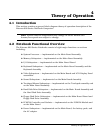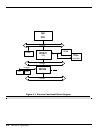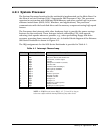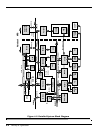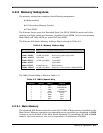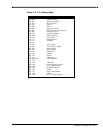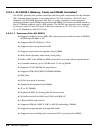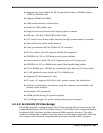
Theory of Operation 4-3
4.2.1 System Processor
The System Processor function for the notebook is implemented on the Main Board in
the form of an Intel Pentium P54-C Superscalar 586 Processor Chip. The processor
operates in conjunction with RAM and ROM Memory and other control logic to process
software instructions (BIOS, DOS, Windows, and applications). The processor
communicates with the hard disk drive and the memory components using high speed
busses.
The Processor also interacts with other hardware logic to provide the power savings
features for the notebook. These features include controlling CPU clock speeds,
reducing clock speeds whenever possible, e.g., when performing floppy disk drive
accesses, powering down unused devices, etc. A detailed block diagram of the Extensa
900 Series Notebook is shown in Figure 4-2.
The IRQ assignments for the 900 Series Notebooks is provided in Table 4-1.
Table 4-1 Interrupt Channel map
Priority Interrupt Number Interrupt Source
1
2
3
4
5
6
7
8
9
10
11
12
13
14
15
16
17
SMI
NMI
IRQ 0
IRQ 1
IRQ 2
IRQ 8
IRQ 9
IRQ 10
IRQ 11
IRQ 12
IRQ 13
IRQ 14
IRQ 15
IRQ 3
IRQ 4
IRQ 5
IRQ 6
IRQ 7
Power management unit
Parity error detected, I/O channel error
Interval timer, counter 0 output
Keyboard
Interrupt from controller 2 (cascade)
Real-time clock
Cascaded to INT 0AH (IRQ 2)
Audio (option) / PCMCIA
Audio (option) / PCMCIA
PS/2 mouse
INT from coprocessor
Hard disk controller
CD-ROM controller
Serial port 2, 4
Serial port 1, 3
Parallel port 1 / audio (option)
Diskette controller
Parallel port 2 / audio (option)
NOTE:
A PCMCIA card can use IRQ 3, 4, 5, 7, 9 and 11 as long as
it does not conflict with the interrupt address of any other device.









